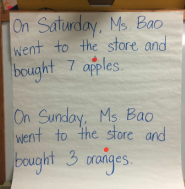Pre-K/Kindergarten Three Read Protocol Link to this section
Many teachers of Kindergarten and First Grade have adapted the 3-Read Protocol for use in their classrooms. Here are some suggested modifications for younger learners.
1. First Read: Teacher reads the problem stem (story) orally.
Use visuals and / or a rebus to accompany the oral read of the problem stem. Students listen to the story with the goal of turning to a partner and sharing what they remember of it. Memorizing it is not necessary.
Key Question: What is this story about?
After the Turn-and-Talk, the teacher asks students to share information they remember from the story. Students may share details that are not from the story, as they try to relate the story to their own context. Teachers and students ask clarifying questions about the vocabulary as needed.
2. Second Read: Teacher reads the problem stem (story) orally. May be omitted if students already talked about the numbers in the story.
Use visuals and / or a rebus to accompany the oral read of the problem stem. Students listen to the story with the goal of turning to a partner and sharing what they remember of it. Memorizing it is not necessary.
Key Question: What are the numbers (or quantities or amounts) in the story?
As students share numbers, the teacher helps them state the units by asking: 25 of what?
3. Third Read: Combined teacher and choral read with images.
The teacher reads the story out loud, asking students to help read the words with images. In this example, students would read "7 apples" and "3 oranges."
Key Question: What do you wonder about this story?
The teacher records all questions that students generate. Students may still be learning what questions are and how to use question words.
4. Students work on a question of their or the teacher's choosing.

This page was last updated on June 30, 2022

